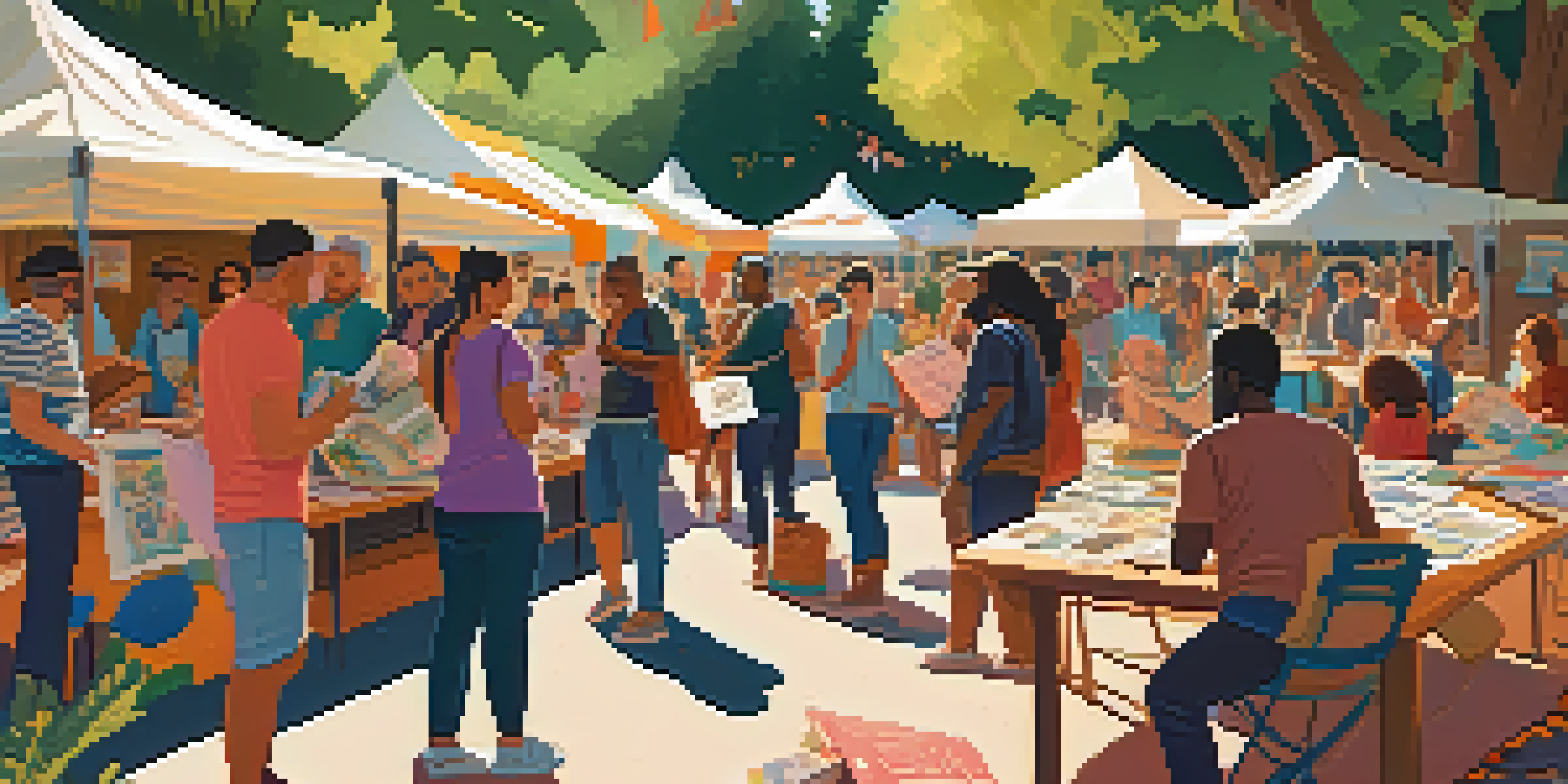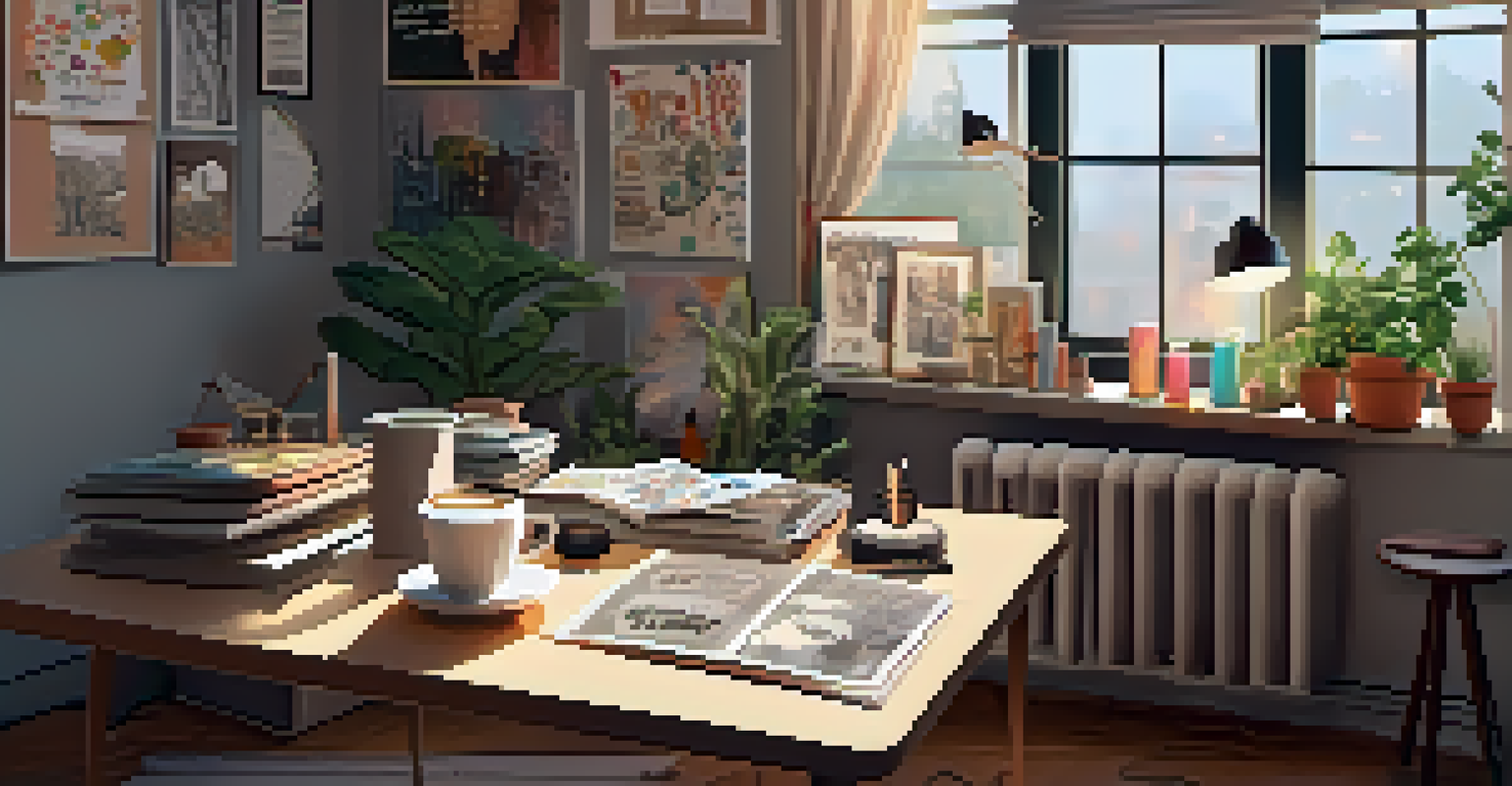The Power of Zines in Grassroots Activist Art

What Are Zines and Their Role in Activism?
Zines, short for magazines, are self-published works that often express personal or political beliefs. They have been a staple of grassroots activism, allowing individuals to share their voices without the constraints of traditional publishing. The charm of zines lies in their DIY nature, making them accessible to anyone with a message to share.
Zines are a way for people to express themselves, to create something unique and to connect with others who feel the same way.
By leveraging zines, activists can articulate their thoughts, raise awareness about social issues, and mobilize communities. These publications often highlight marginalized voices that mainstream media might overlook, creating a rich tapestry of perspectives. In this way, zines serve not just as art, but as vital tools for social change.
For example, during the punk movement of the 1970s and 80s, zines like 'Sniffin' Glue' became platforms for youth to express their dissatisfaction with societal norms. This spirit of rebellion continues today, as new generations use zines to document their experiences and advocate for justice.
Zine Creation: A Medium for Artistic Expression
Creating a zine is an inherently artistic act. From hand-drawn illustrations to unique typography, zines invite creativity in ways that traditional publications often do not. This artistic freedom allows creators to experiment with different styles and formats, making each zine a reflection of its creator's personality.

Moreover, the simplicity of zine-making encourages participation from individuals who may not have formal art training. This inclusivity fosters a sense of community, as creators share their work and collaborate with like-minded individuals. The result is a diverse range of artistic expressions that resonate with various audiences.
Zines Amplify Marginalized Voices
Zines provide a vital platform for activists to express personal and political beliefs, often highlighting perspectives overlooked by mainstream media.
Take the example of 'Riot Grrrl' zines, which emerged from the feminist punk scene in the early 1990s. These zines combined fierce artwork with empowering messages, challenging gender norms and advocating for women's rights. Such movements illustrate how art and activism can intertwine to create powerful social commentary.
Zines as Tools for Education and Awareness
One of the remarkable powers of zines is their ability to educate readers about pressing social issues. Unlike mainstream media, which can be biased or oversimplified, zines often provide in-depth explorations of topics such as climate change, racial justice, and mental health. This depth encourages critical thinking and informed discussions.
The personal is political, and zines are a way to explore that relationship.
By distributing zines within communities, activists can spark conversations that lead to greater awareness and understanding. For instance, zines focused on local issues can inform residents about their rights, resources, and ways to get involved in advocacy. This grassroots approach empowers individuals to take action in their communities.
An example of this can be seen in health-related zines that address topics like sexual health and body positivity. These publications often provide essential information that might not be covered in traditional educational settings, thus filling a crucial gap in knowledge and promoting healthier conversations.
Building Community Through Zine Events
Zine festivals and workshops have become vibrant spaces for community building. These events not only showcase the work of zine creators but also encourage collaboration and networking among activists. Participants often leave feeling inspired and connected, having shared their stories and ideas with others.
Such gatherings provide a platform for marginalized voices to be heard, fostering a sense of belonging. Attendees can exchange zines, share techniques, and discuss their experiences in a supportive environment. This camaraderie strengthens grassroots movements by creating bonds that extend beyond the events themselves.
Zines Foster Community and Collaboration
Events like zine festivals create spaces for creators to network, share ideas, and strengthen grassroots movements through collaboration.
For example, events like the 'Chicago Zine Fest' not only celebrate zine culture but also highlight local issues and initiatives. By bringing together diverse creators, these festivals amplify the voices of those advocating for change, making activism a shared experience.
The Digital Shift: Zines in the Online Space
With the rise of the internet, zines have found a new home online, allowing creators to reach broader audiences. Digital zines can be easily shared via social media, making it simpler for activists to disseminate their messages. This shift has transformed the traditional zine landscape, combining the DIY spirit with the vastness of the digital world.
However, this transition also comes with challenges. While online zines can reach more people, they may lose some of the intimacy and tactile quality of printed works. The act of flipping through a physical zine fosters a personal connection that digital formats might struggle to replicate.
Nevertheless, many creators are finding ways to blend both worlds. For instance, they might print limited editions of their zines while also offering digital versions. This hybrid approach ensures that the essence of zine culture persists, regardless of the medium.
Zines and Intersectionality in Activism
Zines often embody the principles of intersectionality by addressing multiple, overlapping social issues. They allow for nuanced conversations about how factors like race, gender, and class intersect, providing a platform for voices that are often marginalized. This focus fosters understanding and solidarity among diverse communities.
Through zines, creators can share personal narratives that highlight the complexities of their identities. These stories can challenge stereotypes and encourage empathy, fostering a more inclusive atmosphere within activist spaces. By amplifying these voices, zines contribute to a richer dialogue about social justice.
Digital Zines Expand Reach
The transition to online formats allows zines to reach broader audiences, though it challenges the intimate connection found in physical zines.
For instance, zines like 'Black Girl Dangerous' center the experiences of queer people of color, addressing topics often neglected in mainstream discussions. This focus on intersectionality not only educates readers but also strengthens the bonds within activist movements.
Future of Zines in Grassroots Activism
As society continues to evolve, so too will the role of zines in grassroots activism. With new technologies and platforms emerging, zines are likely to adapt while retaining their core purpose of amplifying voices. The potential for innovation in zine-making is limitless, with creators exploring multimedia formats and interactive elements.
Moreover, as social justice movements gain traction worldwide, zines will remain a vital means of documenting these struggles. They serve as historical records of grassroots efforts, capturing the spirit of resistance and resilience in tangible forms. This documentation is crucial for future generations seeking to understand and learn from past movements.

Ultimately, zines are more than just a medium for expression; they are a testament to the power of community and activism. As long as there are stories to tell and causes to champion, zines will continue to thrive as a dynamic force in the world of grassroots art.